Torque Limiter Market Size and Trends
The Torque Limiter Market is estimated to be valued at USD 335.1 Mn in 2025 and is expected to reach USD 484.6 Mn by 2032, growing at a compound annual growth rate (CAGR) of 5.4% from 2025 to 2032.
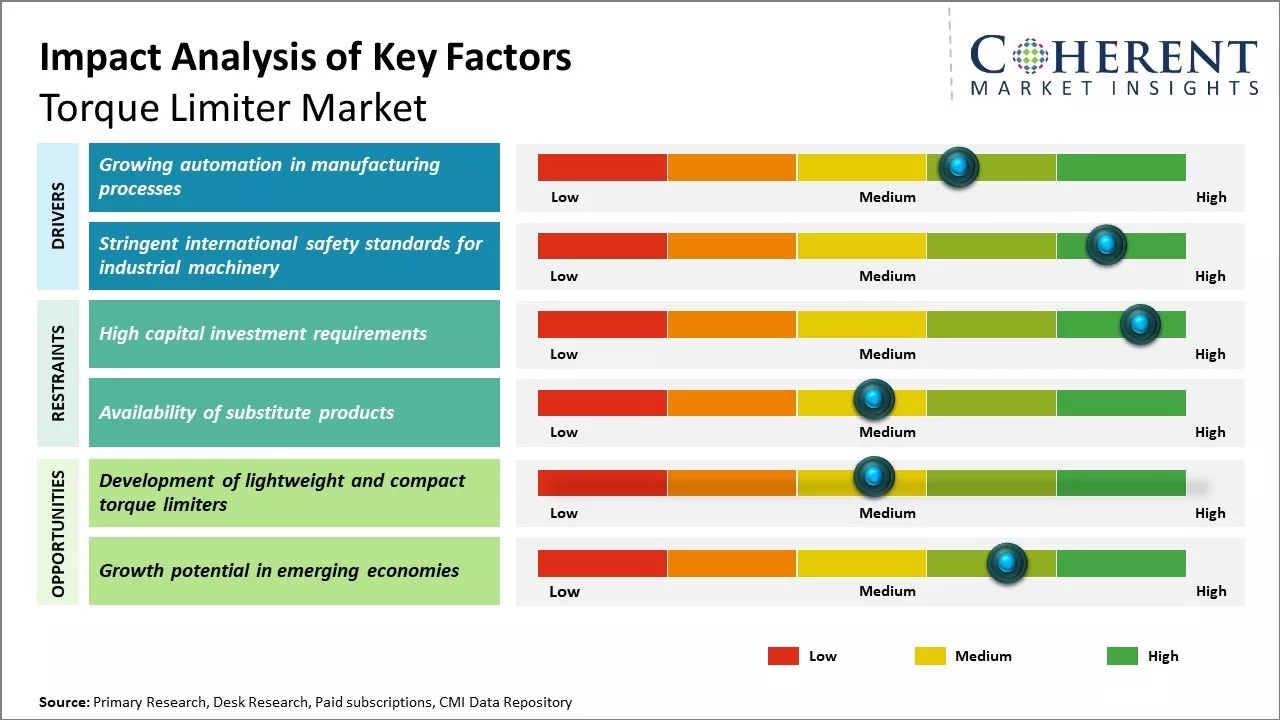
Discover market dynamics shaping the industry: Download Free Sample
The torque limiter market is expected to witness positive growth over the forecast period. The growing demand from industrial machinery and automotive industry is expected to drive the market growth. Torque limiters find widespread applications in machinery to prevent costly damage to gears and other components from over torque. In the automotive industry, torque limiters help improve drivetrain efficiency and reduce wear and tear. The rising installation of torque limiters in electric vehicles to monitor motor output is expected to offer new opportunities for market growth. Overall, increased investments in industrial automation across various end-use industries will boost the adoption of torque limiters through 2032.
Growing automation in manufacturing processes
With rapid advancements in robotics and artificial intelligence, automation has greatly expanded across various manufacturing sectors in recent years. Robots are being utilized for diverse manufacturing activities that involve lifting heavy parts, performing repetitive tasks, working in hazardous environments, and achieving precision that humans may find difficult. However, uncontrolled torque in robotic joints and linkages during operation can cause damage to both machinery and products. Torque limiters play a vital role in preventing such issues by cutting off power transmission beyond safe torque levels.
As industries automate more of their production lines with robots, the demand for torque limiters is surging to ensure safety. Automotive companies are significantly automating their vehicle and component assembly with robots. Even small and medium enterprises are adopting basic robotics for mundane and risk-prone tasks like spraying paints or welding parts. This widespread automation phenomenon has prompted greater awareness among manufacturers about integrating appropriate torque control methods. Torque limiters protect expensive robots and automated machinery from breakage during unplanned situations. They reduce downtime and associated maintenance costs for companies. With global manufacturing expected to become more technology-intensive in future, the need for robust torque control solutions like torque limiters will keep rising steadily.
Market Concentration and Competitive Landscape
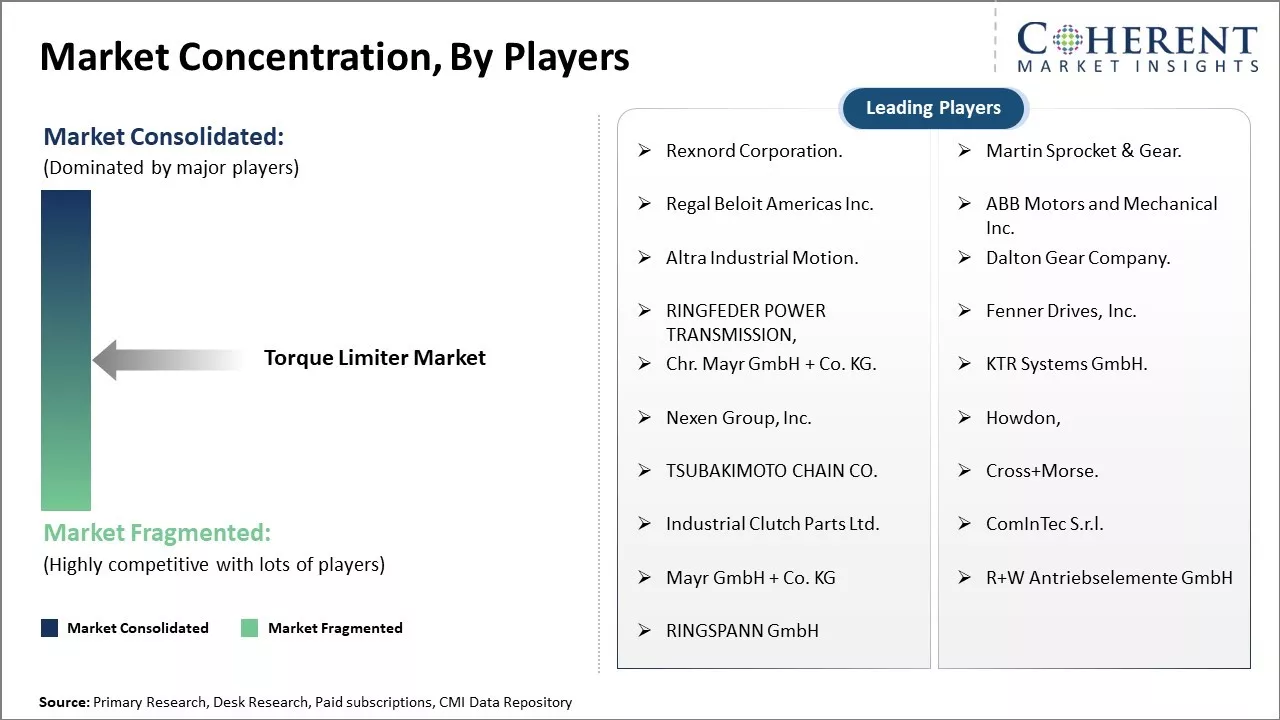
Get actionable strategies to beat competition: Download Free Sample
Market Drivers: Stringent international safety standards for industrial machineryInternational regulatory bodies like the European Union and Occupational Safety and Health Administration have stipulated stringent guidelines in recent years regarding safety of industrial equipment and machinery used in workplaces. Employers are legally obligated to comply with these standards to protect workers from accidents. Any industrial device that involves risk of uncontrolled torque now needs to integrate certified safety features. Torque limiters have emerged as one of the most effective solutions to adhere to workplace safety laws.
Many industries which employ a large manufacturing and assembly workforce like food and beverage, packaging, mining, energy, and construction increasingly rely on various power tools and automated machinery. Unintended torque surges in rotating parts or linkages of these machines can lead to serious injuries. Incorporating torque limiters set at exact load limits has now become imperative from a regulatory perspective. Manufacturers cannot afford legal non-compliance which can invite hefty penalties. This drives the need to outfit more industrial machines with reliable torque control systems like limiters that offer verifiable safety. Stricter implementation of safety norms across key global markets will propel the demand for proven torque limiting technology in the coming years.
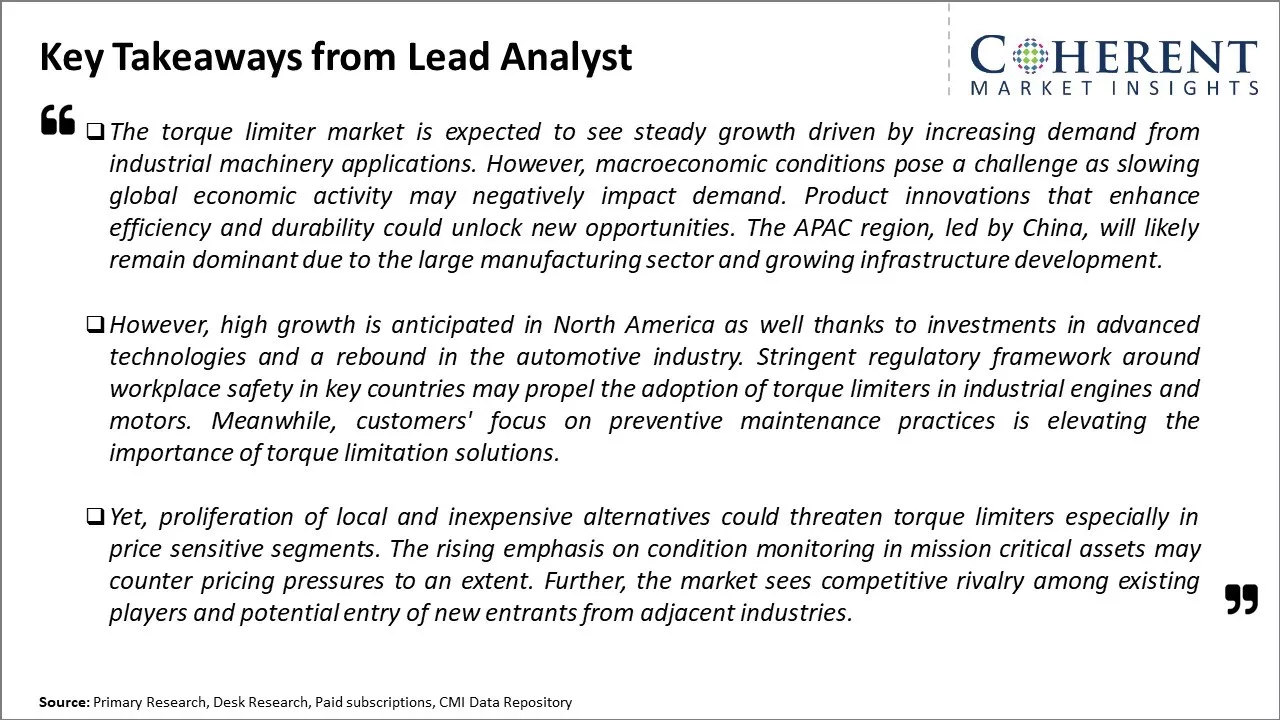
To learn more about this report, Download Free Sample
Market Challenges: Cost Constraints and Efficiency Demands Hinder AdoptionEquipment manufacturers are under constant pressure to reduce costs and improve efficiency, making them reluctant to adopt new technologies without a clear business case. Additionally, many end users lack awareness of how torque limiters can benefit their operations and protect machinery. Changing to new suppliers also requires investment in training and integration with existing systems. Market growth may be hampered if OEMs do not see torque limiters as a high priority or necessary addition.
Market Opportunities: Automation Drives Safety Mechanism Demand
Increasing automation across industries raises demands for safety mechanisms to prevent damage from over torque. Stricter regulations around workplace safety and asset protection are also driving adoption. as equipment operates closer to torque limits. Rising demands for energy efficiency could push manufacturers to integrate torque limiters that optimize motor use. Additionally, growth in sectors like agriculture, construction and wind and solar has opportunities to grow the market further.
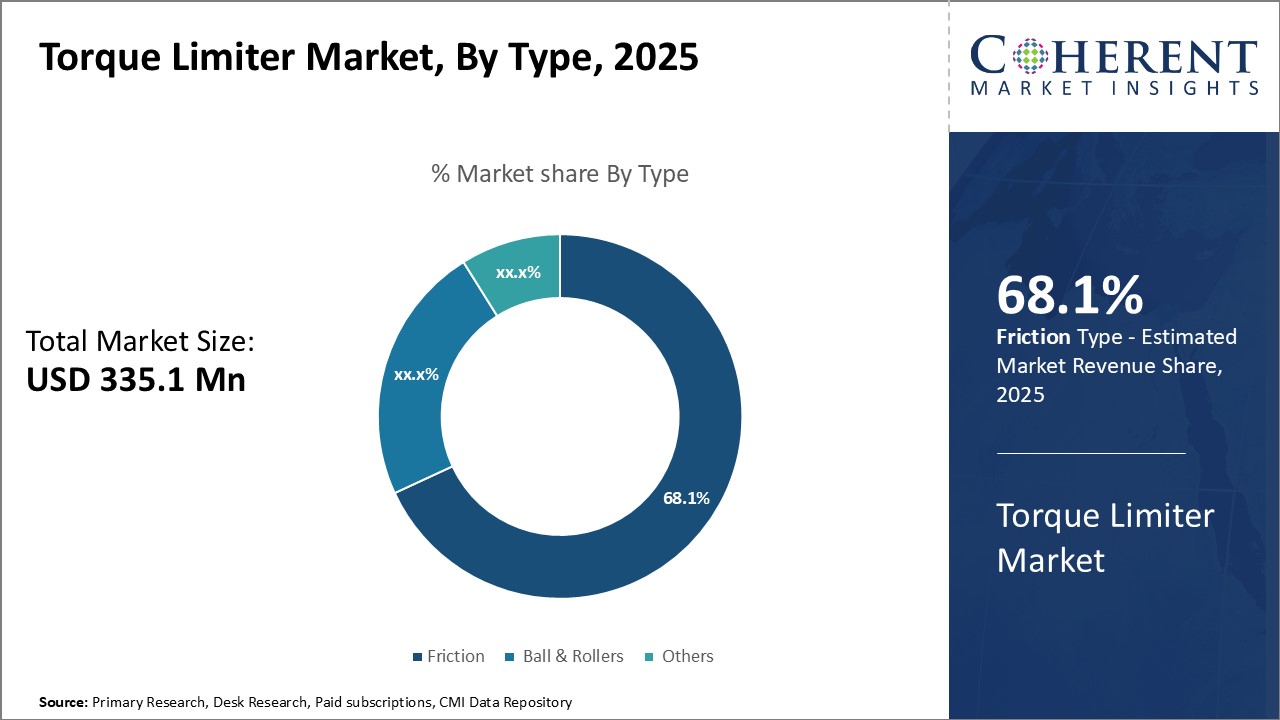
Discover high revenue pocket segments and roadmap to it: Download Free Sample
Insights, By Type- Engineering and design simplicity drive the popularity of friction torque limiters
In terms of type, friction contributes the highest share of the torque limiter market owing to its inherent engineering and design simplicity compared to other variants. Friction torque limiters utilize the mechanical friction between two surfaces to achieve torque limiting functionality. They are easy and inexpensive to manufacture as they avoid complexities associated with other technologies such as precise moving parts or sophisticated controls. Their operation is reliable, repeatable, and not dependent on precise interactions between subcomponents. This simplicity enables friction torque limiters to be applied across a wide range of torque and speed requirements through minor adjustments in design. They are also tolerant to shock loads and transient spikes in torque better than more sophisticated alternatives. Friction limiters minimize maintenance needs and downtime as they have fewer failure prone components compared to competitors. In high volume and cost sensitive applications, this total cost of ownership drives strong demand for friction torque limiters.
Insights, By Range- Standardized output requirements fuel the popularity of low torque ranges
In terms of range, the up to 150 Nm segment contributes the highest share of the torque limiter market. The standardized torque output requirements across many basic industrial processes and machinery. Machines performing fundamental tasks such as packaging, low intensity mixing, or material handling generally require torque limiting below 150 Nm. This segment allows for standardized torque limiting solutions to be applied across a variety of common industrial equipment with minimal customization. It benefits from economies of scale in both component manufacturing and inventory holding. Suppliers achieve good margins catering to the repetitive needs of this volume driven segment. For cost sensitive and low complexity applications, low torque limiters matching typical operating parameters are preferable to complex customized solutions.
Insights, By End Use- Critical production processes dependence drives demand from steel industries
In terms of end use, the steel plants & rolling mills segment contributes the highest share to the torque limiter market due to critical torque control needs across steel production processes. Torque limiting is essential in core equipment such as pay off machines, pay in systems, and rolling mills to prevent damage from over torque during material feed operations. Unplanned shut downs even for a few hours in large integrated steel plants can exponentially increase losses and impact downstream supplies. Reliable torque control ensures uptime of critical production assets. The large capital invested and safety requirements in primary steelmaking further increase dependence on torque limiting technology. This strategic importance as well as large scale of operations drives the outsized demand from steel industries for robust and high capacity torque limiters tailored to their specific torque and speed parameters.
Regional Insights
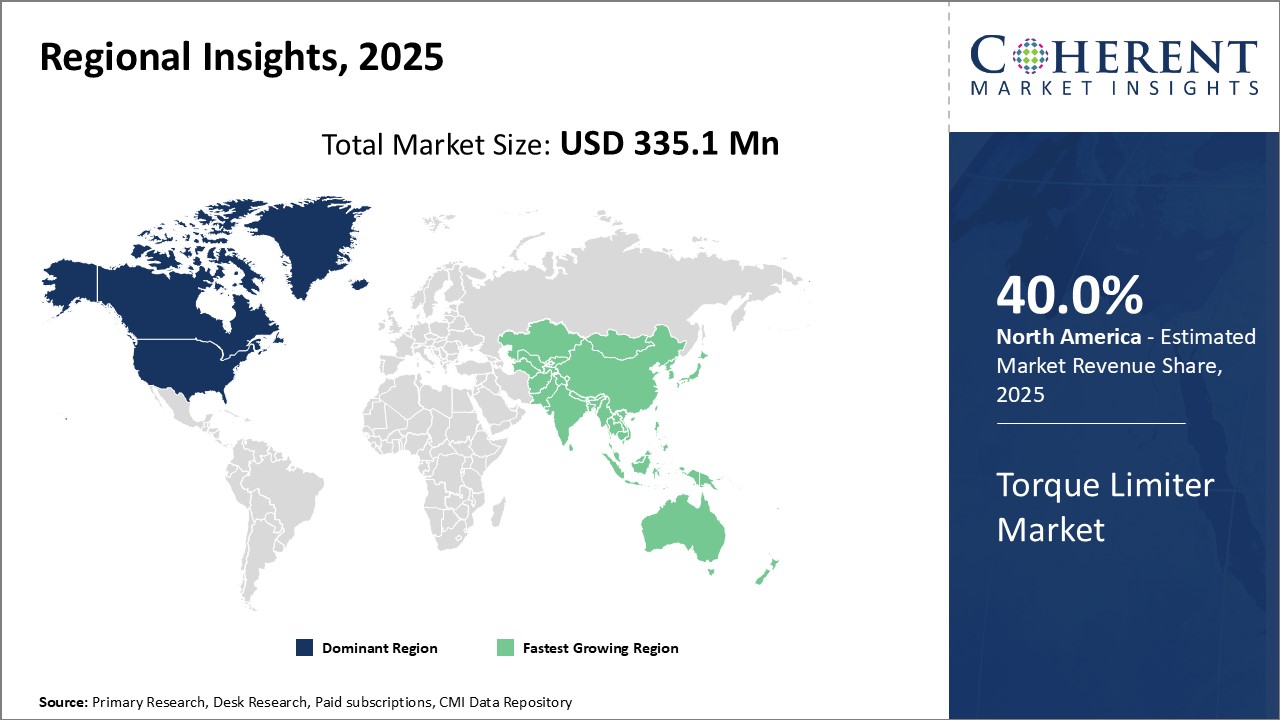
Need a Different Region or Segment? Download Free Sample
North America has established itself as the dominant region in the global torque limiter with market share of 40.0% in 2025. The presence of major automotive and industrial manufacturing hubs in the U.S. and Canada has propelled the demand for torque limiters in this region. With the strong automotive aftermarket in the U.S., torque limiters find widespread applications for repair and maintenance purposes. In addition, strong emphasis on workplace safety and productivity in the industrial sector have increased the adoption of torque limiters.
The major industry participants in North America focus on innovating their product portfolio and catering to specific customer needs to maintain dominance. Stringent manufacturing standards facilitate the production of high-quality torque limiters. Furthermore, the region is known for its early adoption of advanced technologies which aid incorporation of newer materials and develop customized torque limiters. Easy availability of raw materials and components within the region also make North America a lucrative manufacturing base for torque limiters.
The Asia Pacific region has emerged as the fastest growing regional market for torque limiters globally. With countries like China, Japan, and India driving strong demand from the automotive, machinery, and industrial automation sectors, the requirement for torque limiters is increasing at a rapid pace. Rapid industrialization and infrastructure development contribute significantly to the Asia Pacific's rising prominence.
China, in particular, has established itself as a major manufacturer and exporter of automotive and industrial equipment. Hence, the need for dependable torque control solutions is gaining traction. Additionally, industry participants view Asia Pacific as an attractive outsourcing hub which adds to the regional supply. Furthermore, the availability of relatively cheaper labor and raw materials provides a competitive advantage for torque limiter production in Asia Pacific. Overall, with its massive industrial and machinery sectors, Asia Pacific is expected to be at the forefront of the global torque limiter demand.
Market Report Scope
Torque Limiter Market Report Coverage
| Report Coverage | Details | ||
|---|---|---|---|
| Base Year: | 2024 | Market Size in 2025: | USD 335.1 Mn |
| Historical Data for: | 2020 To 2024 | Forecast Period: | 2025 To 2032 |
| Forecast Period 2025 to 2032 CAGR: | 5.4% | 2032 Value Projection: | USD 484.6 Mn |
| Geographies covered: |
|
||
| Segments covered: |
|
||
| Companies covered: |
Rexnord Corporation., Martin Sprocket & Gear., Regal Beloit Americas Inc., ABB Motors and Mechanical Inc., Altra Industrial Motion., Dalton Gear Company., RINGFEDER POWER TRANSMISSION,, Fenner Drives, Inc., Chr. Mayr GmbH + Co. KG., KTR Systems GmbH., Nexen Group, Inc., Howdon,, TSUBAKIMOTO CHAIN CO., Cross+Morse., Industrial Clutch Parts Ltd., ComInTec S.r.l., Mayr GmbH + Co. KG, R+W Antriebselemente GmbH, and RINGSPANN GmbH |
||
| Growth Drivers: |
|
||
| Restraints & Challenges: |
|
||
Uncover macros and micros vetted on 75+ parameters: Get instant access to report
Torque Limiter Industry News
- In September 2023, the UK Ministry of Defense awarded BAE Systems plc a contract worth USD 48.9 million to make the Striker II Digital Helmet-Mounted Display for Typhoon fighter pilots. This new helmet is a fully digital upgrade from the previous Striker model.
- In April 2023, DuPont introduced a new type of Kevlar called Kevlar EXO aramid fiber. It's lighter, more flexible, and more effective as body armor compared to previous versions, marking a significant advancement in technology.
- In February 2021, DuPont de Nemours Inc. acquired Core Matrix Technology from Tex Tech Industries Inc. This technology includes a monolith fabric structure that enhances bullet fragmentation and ballistic performance for military personnel, as well as reduces back trauma. This acquisition is expected to expand DuPont's portfolio of life protection products.
- In January 2021, the Ukrainian Defense Ministry developed a ballistic vest that meets NATO standards. These vests are issued as standard equipment for land forces and a lighter version is available for special forces.
*Definition: The torque limiter market consists of companies that manufacture torque limiters and torque limiting couplings. Torque limiters are mechanical safety devices used to prevent mechanical damage by limiting the amount of torque transmitted through a drive shaft. They are used in industrial applications like conveyor belts, packaging machinery, printing presses, and material handling equipment to protect gears, bearings, and other components from overturning caused by jamming or stalling.
Market Segmentation
- Type Insights (Revenue, USD MN, 2020 - 2032)
- Friction
- Ball and rollers
- Others
- Range Insights (Revenue, USD MN, 2020 - 2032)
- Up to 150 Nm.
- 151–500 Nm.
- 501–3,000 Nm.
- Greater than 3,000 Nm
- End-use Insights (Revenue, USD MN, 2020 - 2032)
- Steel Plants & Rolling mills.
- Plastic & Rubber.
- Paper & Printing.
- Fabricated Metal Manufacturing.
- Packaging & Labelling.
- Energy & Power.
- Others.
- Regional Insights (Revenue, USD MN, 2020 - 2032)
- North America
- U.S.
- Canada
- Latin America
- Brazil
- Argentina
- Mexico
- Rest of Latin America
- Europe
- Germany
- U.K.
- France
- Italy
- Russia
- Rest of Europe
- Asia Pacific
- China
- India
- Japan
- Australia
- South Korea
- ASEAN
- Rest of Asia Pacific
- Middle East & Africa
- GCC Countries
- South Africa
- Rest of Middle East & Africa
- North America
- Key Players Insights
- Rexnord Corporation.
- Martin Sprocket & Gear.
- Regal Beloit Americas Inc.
- ABB Motors and Mechanical Inc.
- Altra Industrial Motion.
- Dalton Gear Company.
- RINGFEDER POWER TRANSMISSION,
- Fenner Drives, Inc.
- Chr. Mayr GmbH + Co. KG.
- KTR Systems GmbH.
- Nexen Group, Inc.
- Howdon,
- TSUBAKIMOTO CHAIN CO.
- Cross+Morse.
- Industrial Clutch Parts Ltd.
- ComInTec S.r.l.
- Mayr GmbH + Co. KG
- R+W Antriebselemente GmbH
- RINGSPANN GmbH
Share
Share
About Author
As an accomplished Senior Consultant with 7+ years of experience, Pooja Tayade has a proven track record in devising and implementing data and strategy consulting across various industries. She specializes in market research, competitive analysis, primary insights, and market estimation. She excels in strategic advisory, delivering data-driven insights to help clients navigate market complexities, optimize entry strategies, and achieve sustainable growth.
Missing comfort of reading report in your local language? Find your preferred language :
Transform your Strategy with Exclusive Trending Reports :
Frequently Asked Questions
EXISTING CLIENTELE
Joining thousands of companies around the world committed to making the Excellent Business Solutions.
View All Our Clients
